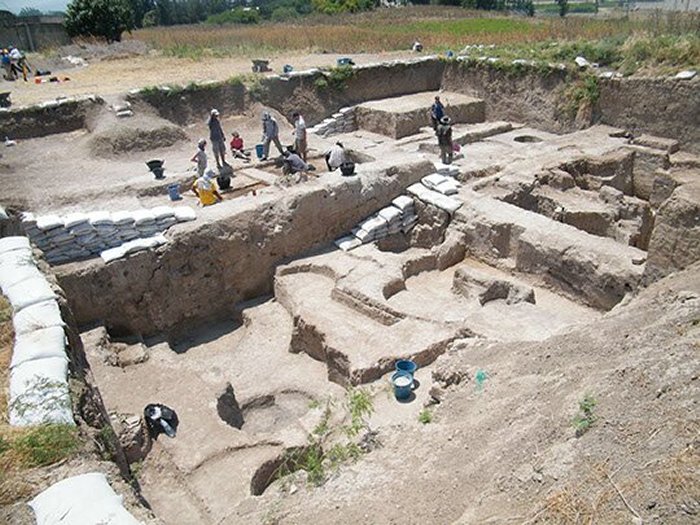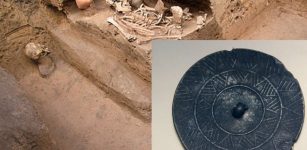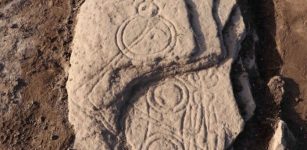Ancient Tell-Tayinat Inhabitants And Climate Change Resilience – New Study
Conny Waters - AncientPages.com - An examination of two documented periods of climate change in the greater Middle East, between approximately 4,500 and 3,000 years ago, reveals local evidence of resilience and even of a flourishing ancient society despite the changes in climate seen in the larger region.
 Microscope image of Iron Age oak twig from Tell Tayinat in Hatay, Turkey. Credit: Brita Lorentzen
Microscope image of Iron Age oak twig from Tell Tayinat in Hatay, Turkey. Credit: Brita Lorentzen
A new study led by the University of Toronto and Cornell University archaeologists working at Tell Tayinat in southeastern Turkey demonstrates that human responses to climate change are variable and must be examined using extensive and precise data gathered at the local level.
The study highlights how challenge and collapse in some areas were matched by resilience and opportunities elsewhere, and shows human responses to climate change that broaden an otherwise sparse chronological framework for the northern part of the region known historically as the Levant, which stretches the length of the eastern edge of the Mediterranean Sea.
"The study shows the end of the Early Bronze Age occupation at Tayinat was a long and drawn-out affair that, while it appears to coincide with the onset of a megadrought 4,200 years ago, was actually the culmination of processes that began much earlier," says Tim Harrison, professor and chair of the Department of Near & Middle Eastern Civilizations in the Faculty of Arts & Science at the University of Toronto (U of T), and director of the Tayinat Archaeological Project.
"The archaeological evidence does not point towards significant local effects of the climate episode, as there is no evidence of drought stress in crops."
 View of Early Bronze Age excavation (Field 1) at Tell Tayinat in Hatay, Turkey. Credit: Tayinat Archaeological Project
View of Early Bronze Age excavation (Field 1) at Tell Tayinat in Hatay, Turkey. Credit: Tayinat Archaeological Project
"Instead, these changes were more likely the result of local political and spatial reconfiguration."
The mid-to-late Early Bronze Age (3000-2000 BCE) and the Late Bronze Age (1600-1200 BCE) in the ancient Middle East are pivotal periods of early inter-connectedness among settlements across the region, with the development of some of the earliest cities and state-level societies. But these systems were not always sustainable, and both periods ended in collapse of civilisations/settlements, the reasons for which are highly debated.
The absence of detailed timelines for societal activity throughout the region leaves a significant gap in understanding the associations between climate change and social responses. While the disintegration of political or economic systems are indeed components of societal response, collapse is rarely total.
Using radiocarbon dating and analysis of archaeological samples recovered from Tell Tayinat, a location occupied following two particularly notable climate change episodes 4,200 and again 3,200 years ago, the Toronto-Cornell team established a robust chronological timeframe for Tayinat for these two pivotal periods in the history of the ancient Middle East.
"The absolute dating of these periods has been a subject of considerable debate for many years, and this study contributes a significant new dataset that helps address many of the questions," says Sturt Manning, Goldwin Smith Professor of Classical Archaeology in the Department of Classics at Cornell University's College of Arts & Sciences, and lead author of the study.
"The detailed chronological resolution achieved in this study allows for a more substantive interpretation of the archaeological evidence in terms of local and regional responses to proposed climate change, shedding light on how humans respond to environmental stress and variability."
The researchers say the chronological framework for the Early Iron Age demonstrates the thriving re-settlement of Tayinat following the 3,200 years ago event during a reconstructed period of heightened aridity.
"The settlement of Tayinat may have been undertaken to maximize access to arable land, and crop evidence reveals the continued cultivation of numerous water-demanding crops, revealing a response that counters the picture of a drought-stricken region," says Harrison.
"The Iron Age at Tayinat represents a significant degree of societal resilience during a period of climatic stress."
Written by Conny Waters - AncientPages.com Staff Writer
More From Ancient Pages
-
 First Evidence Of Canoe Burial With Remains Of A Woman Discovered In Argentinian Patagonia
Archaeology | Aug 27, 2022
First Evidence Of Canoe Burial With Remains Of A Woman Discovered In Argentinian Patagonia
Archaeology | Aug 27, 2022 -
 48,000-Year-Old Tooth That Belonged To Neanderthal Child Found In Northern Italy
Fossils | Sep 19, 2020
48,000-Year-Old Tooth That Belonged To Neanderthal Child Found In Northern Italy
Fossils | Sep 19, 2020 -
 Timur: Brutal Military Leader And His Desire To Conquer But Not To Rule
Featured Stories | Mar 13, 2019
Timur: Brutal Military Leader And His Desire To Conquer But Not To Rule
Featured Stories | Mar 13, 2019 -
 Senegambia’s Circles: Largest Cluster Of Megalithic Structures Of Lost Civilization On Earth
Featured Stories | Jan 3, 2020
Senegambia’s Circles: Largest Cluster Of Megalithic Structures Of Lost Civilization On Earth
Featured Stories | Jan 3, 2020 -
 Qijia Culture – Its Disappearance Remains An Ancient Mystery
Civilizations | Feb 5, 2021
Qijia Culture – Its Disappearance Remains An Ancient Mystery
Civilizations | Feb 5, 2021 -
 Rare Pictish Symbol Stone Found Near The Battle Of Nechtansmere Site
Archaeology | Mar 7, 2022
Rare Pictish Symbol Stone Found Near The Battle Of Nechtansmere Site
Archaeology | Mar 7, 2022 -
 Ancient African Empires’ Impact On Migration Revealed By Genetics
Archaeology | Mar 31, 2023
Ancient African Empires’ Impact On Migration Revealed By Genetics
Archaeology | Mar 31, 2023 -
 Fascinating Millennia Old Natufian Culture: Funerals With Flowers, Food And Pounding Sound Of Mortars
Civilizations | Aug 22, 2015
Fascinating Millennia Old Natufian Culture: Funerals With Flowers, Food And Pounding Sound Of Mortars
Civilizations | Aug 22, 2015 -
 The Green Knight – New Movie Based On Arthurian Legend
Myths & Legends | Aug 7, 2021
The Green Knight – New Movie Based On Arthurian Legend
Myths & Legends | Aug 7, 2021 -
 Mystery Of The Ancient Red Sign Witnessed In The Sky Over Japan
News | Mar 31, 2020
Mystery Of The Ancient Red Sign Witnessed In The Sky Over Japan
News | Mar 31, 2020 -
 On This Day In History: Samuel F.B. Morse Receives A Patent For His Dot-Dash Telegraphy Signals – On June 20, 1840
News | Jun 20, 2016
On This Day In History: Samuel F.B. Morse Receives A Patent For His Dot-Dash Telegraphy Signals – On June 20, 1840
News | Jun 20, 2016 -
 Earliest Known Abecedary Engraved On Shard Of Pottery Dated To 15th Century BC – Deciphered
Archaeology | Oct 23, 2015
Earliest Known Abecedary Engraved On Shard Of Pottery Dated To 15th Century BC – Deciphered
Archaeology | Oct 23, 2015 -
 Giant Ancient Roman Underground Structure Discovered Near Naples, Italy – Aqua Augusta Investigated
Archaeology | Feb 6, 2023
Giant Ancient Roman Underground Structure Discovered Near Naples, Italy – Aqua Augusta Investigated
Archaeology | Feb 6, 2023 -
 Roman Consuls Seized Power Through Intimidation, Bribery And Show Business
Ancient History Facts | Mar 4, 2025
Roman Consuls Seized Power Through Intimidation, Bribery And Show Business
Ancient History Facts | Mar 4, 2025 -
 The Enigma Of The ‘Ancient Ones’, The Anasazi Cliff-Dwellers Of The Southwestern United States
Ancient Mysteries | Apr 9, 2017
The Enigma Of The ‘Ancient Ones’, The Anasazi Cliff-Dwellers Of The Southwestern United States
Ancient Mysteries | Apr 9, 2017 -
 Face Of Iron Age Female Druid Reconstructed
Archaeology | Aug 20, 2019
Face Of Iron Age Female Druid Reconstructed
Archaeology | Aug 20, 2019 -
 Mysterious 1,800-Year-Old Roman Marble Inscription Found In The Ancient City Of Aigai Deciphered
Archaeology | Oct 5, 2022
Mysterious 1,800-Year-Old Roman Marble Inscription Found In The Ancient City Of Aigai Deciphered
Archaeology | Oct 5, 2022 -
 Skirnir’s Mission To Jotunheim To Gain Gerda For Lovesick God Frey
Featured Stories | Mar 14, 2020
Skirnir’s Mission To Jotunheim To Gain Gerda For Lovesick God Frey
Featured Stories | Mar 14, 2020 -
 Rare 1,000 Year-Old Crusader-Era Bird Pendant Discovered
Archaeology | Mar 28, 2023
Rare 1,000 Year-Old Crusader-Era Bird Pendant Discovered
Archaeology | Mar 28, 2023 -
 Scientific ‘Detective Work’ With South American Mummies Reveals They Were Brutally Murdered
Archaeology | Sep 9, 2022
Scientific ‘Detective Work’ With South American Mummies Reveals They Were Brutally Murdered
Archaeology | Sep 9, 2022
